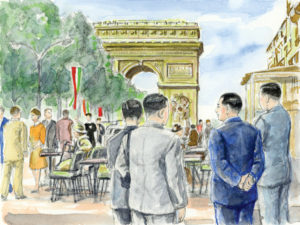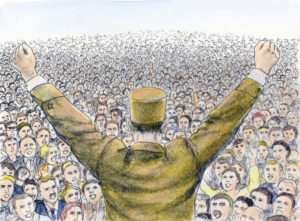Chapter Summary

Illustration courtesy of Seikyo Press.
On the evening of October 8, 1961, Shin’ichi Yamamoto and his companions did a solemn gongyo in his hotel room in Germany. Earlier that day, he had stood before the Berlin Wall [the symbol of Berlin’s physical and ideological division]. In his prayers, Shin’ichi made a powerful pledge to see Germany reunited and to bring about world peace.
After gongyo, he shared his resolve to pursue a course of dialogue with different world leaders to melt Cold War tensions. He also talked about the importance of promoting cultural exchange as a way to foster heart-to-heart ties among people to open the way for peace.
The next morning, Shin’ichi’s party traveled by plane and by car to visit Cologne, a city famous for its diesel engine factory and historic buildings. After the factory tour, they dined with several directors of the company. Seeing the enthusiasm and curiosity with which the German attendees asked about Buddhist humanism, Shin’ichi became further convinced that it was possible for people of any race or nationality to transcend differences and understand one another.
After spending one day in the Netherlands, they flew to Paris, France, on October 11. They saw the Arc de Triomphe and other popular sites before making their way to the Louvre, one of the world’s foremost art museums. There, Shin’ichi observed that art is an expression of humanity, stating that it is imbued with freedom and diversity, the exact opposite of the kind of barbarism that seeks to suppress and control people by military force, violence or other external pressures (see p. 30).
The party flew to London, England, on October 13. That evening, Shin’ichi decided to designate Soka Gakkai contact persons for West Germany (now Germany), France and the United Kingdom as well as a central contact person for all of Europe.
On the morning of the 14th, the group set out early for sightseeing. In the afternoon, while strolling through a park, Shin’ichi struck up a conversation with an elderly gentleman sitting on a bench. Their friendly exchange made him reflect on the importance of establishing a good network of care in an increasingly aging society.
Unforgettable Scene

Illustration courtesy of Seikyo Press.
Courageous Action Paves the Way
During his October 1961 visit to Paris, France, Shin’ichi Yamamoto talked about General Charles de Gaulle, who led the liberation of Paris from Nazi Germany occupation.
When General de Gaulle stepped to the microphone on a platform set up in the square, he threw his arms above his head in the shape of a V—a great declaration of victory.
■ ■ ■
When the parade reached Notre Dame, there was a sudden crack of gunfire. People dove for cover in panic as several more shots rang out. But General de Gaulle remained calm and unruffled, as if nothing had happened.
■ ■ ■
[Shin’ichi Yamamoto] continued: “With strong, unwavering determination, coupled with courageous action, a leader overcomes adversity and paves the way for victory. Just as a tiny flame can grow into a raging wildfire, strong resolve and courageous action can inspire others, enabling them to transform things for the better.
“What was the source of General de Gaulle’s strong determination? It was his conviction that ‘I am France.’ In our case, this would be the awareness that ‘I am the Soka Gakkai.’ This means, instead of relying on others, to take full responsibility, to take complete initiative as the key player—to have the conviction that, ‘If I fail, everyone will suffer.’ This kind of commitment makes a person strong. Let us, too, win in all our struggles, no matter how bitter or harsh, and march proudly through the Arc de Triomphe of kosen-rufu.” (The New Human Revolution, vol. 5, pp. 25–27)
Key Passage
If Soka Gakkai members continued to develop webs of compassion and harmonious relationships with their neighbors and acquaintances, they could transform the human desert that was so characteristic of urban society into a spiritual oasis. (NHR-5, 57)
You are reading {{ meterCount }} of {{ meterMax }} free premium articles

